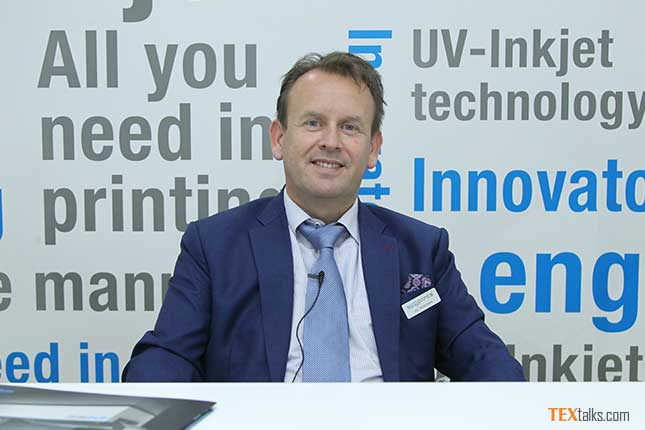SPGPrints is a leading global company in the textile, label and industrial printing markets. It provides total system solutions, with a portfolio including screens, lacquers, inks, digital engravers, and a broad range of rotary screen and digital printing systems. The company has applied its electroforming expertise to developing highly reliable rotary screen technology.
At ITMA Asia 2018, Mr Jos Notermans, Manager Digital Textiles, SPGPrints B.V., The Netherlands, talking to TEXtalks said that Storks, now known as SPGPrints, made its first landmark by inventing rotary printing which gave SPGPrints its leading position in the market in textile printing. In 1986, a study was commissioned to come to an awareness of any technology that could replace rotary screen printing in the near future. According to the study by 2000, all printing in textile would be done digital. Hence, SPGPrints immediately started working on a project to develop a digital textile printer. The first digital textile printer was launched in Hanover ITMA 1991, which could print 1 sq meter per hour. Although visitors were thrilled at printing without repetition and unlimited colors but in comparison to rotary screen printing speed of 80 meters per minute, faster digital printers were demanded. Later on, in 2000, it was realized that the study conclusion was wrong and only 1pc of textile printing was being done digitally. In 2015, SPGPrints in ITMA Milan showed PIKE, a digital printer which runs at the speed of a rotary screen, has zero screen changing downtime, doubling the production capacity.
Informing about the future of rotary screen printing in the global textile market Mr Jos Notermans said that rotary printing is still very cost effective as compared to digital printing. According to some customers, some designs are printed better in rotary screens. The fabric buyer doesn’t care if it was printed digital or rotary. So we give our customers the possibility of choosing for themselves whether digital or rotary. This is the key message, SPGPrints is bringing to ITMA Barcelona in 2019. At ITMA Barcelona, we will present digital and rotary printing side by side. Between digital and rotary printing, it’s not a competition, we want to provide all solutions.
In terms of sustainability, a lot of steps have been taken not only in the digital printing but also in the conventional printing. SPGPrints have taken initiatives to ensure sustainability globally and also were the main visionary sponsors Textile Summit 2015. Water that is used in SPGPrints production plant is cleaned by the water treatment facility and reused by the factory. Rotary screen production plants in Holland, India, Brazil and China, are taking all the measures to be line with sustainability goals and laws of the company and in many cases they are even stricter than what the country requires. The same sustainability standards are used everywhere that have been defined by the company. At another ink treatment plant, no drop of water that is used in the ink facility goes to the sewer system.
Rotary screen printing still shows growth potential. Mr Jos Notermans explained in terms of digital printing that at the moment approximately 30 billion sq meters of fabric is printed globally which grows relative to world population per year about 1-2pc. So, even with a growth of 20-30pc of the digital printing market, the growth is smaller than the growth of the total market and the difference is still covered by rotary printing. We are still manufacturing rotary screen printers at our factory in India and are selling them worldwide. We believe, that our customers should have the choice of how to print because both methods have their advantages. If you want to print 500 meters of a fabric digital printing will be cheaper but if you want to print 50,000 meters of the fabric then rotary printing will be cheaper.
Highlighting the importance of digital ink quality he further added that inks should have color strength, light fastness, rub fastness, wash fastness and similar qualitative properties of rotary printing paste. Conventional low quality dye doesn’t much impact rotary printing but they are a big problem in digital printing. Developing Nebula, PIKE and Javelin inks, with all of them SPGPrints strives to the highest grades of purity which also increases the print heads lifetime. So, based on price a customer can decide to buy cheaper ink but the ink will damage the print head which is a bigger expense. But, buying quality ink will result in triple the saving by saving the cost incurred by print head replacement.
Talking about state of the art Archer Technology he stressed that in textiles with three dimensional structure, the print heads needs to be away from the textile to not damage the print head. Because of this, ink mist can be encountered with due to spattered ink droplets. The Fuji Films Samba heads used in the Archer technology are the first print heads made for textiles. So, archer technology maintains the required distance as well as take away the ink mist, meanwhile, also enhances the print heads lifetime enabling SPGPrints to give a 30 months warranty on print heads. Archer technology is a wish list for textile printing including ink viscosity, jetting speed and drop size.
SPGPrints Experience Centre has been built specifically for two main goals which are giving customers the firsthand experience digital printing with their fabrics and their designs, themselves with our experts as their guide and to create an intermediate step where SPGPrints can run test drive of their machines in their own facility but in customer environment to know the pros and cons of the new development before releasing it into the market. We are very happy that the it is fulfilling for what we have founded it.



